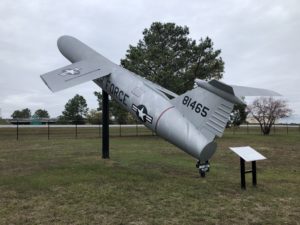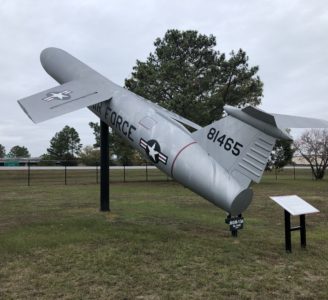Guy Vanderman was elected TAC Missileers President in September, at the the 2019 TAC Missileers Reunion in Newport News, VA. Guy served as a Mace B Guidance Tech with the 498th TMG at Kadena AB, Okinawa, Japan. He has kindly shared the following memoir.
Memoirs of MACE B Missile Guidance Tech (1964 – 1967)
by Guy Vanderman
TAC Missileers President

Through over 55 years of working with many Air Force, Navy and Army weapon systems and special projects, and some might say a successful career, both military and civilian, I have always had a fondness for where I got my start. The following is how and why:
I enlisted in the Air Force in January 1964, not from any great desire to be associated with the service, but since the Air Force could get me on my way to basic training quicker than the other three services. Otherwise I could have just as easily become a marine, soldier or sailor. Barely graduating from high school and not an academic star for sure, the service seemed like the only reasonable option for me at the time at least in my eighteen-year-old infinite wisdom.
My aptitude tests allowed me to volunteer for the electronic field and during basic training, when I got notified of my assignment to the MACE missile school at Lowry AFB, CO I was pretty disappointed as I envisioned ballistic missiles as my choice versus the already old cruise missile system. I immediately started to plot how I might be able to get out of the assignment. It was also at Lowry that I learned not to be a smart aleck and piss off a Squadron First Sergeant, specifically Chief Master Sergeant Mahoney. Got to spend my share of time on crap details including sweeping, mopping waxing and buffing every square inch of the “Green Monster.”
I decided to do poorly in technical school then perhaps I would be given other choices. I noticed that some airmen that flunked out of school seemed to get assignments to Orlando AFB, FL working on other systems and not having to go overseas right away following tech school. I got counseled by a captain and he basically told me that he knew exactly what I was trying to do, and it would not work, he would make sure of it. I had no other option available than MACE B Guidance, period.
It was a result of that counseling that I finally got my head out and decided if I couldn’t lick them, I would join them and become the best guidance technician I could be. I hit the books and made up for my previous peccadillos and managed to graduate and be on my way to the next level of guidance training at Orlando AFB, FL. What a dream assignment Orlando turned out to be.
It was there I met a TSgt Knolle. I don’t remember that much about him now other than he had been in the German Luftwaffe and had come to the US after the war. I quickly figured out how important it was to learn from him and the other old head instructors we had that knew just about everything there was to know about the AN-DJW4 Guidance Set. It was a good school and I studied hard, for me anyway, and all too shortly found myself on the way to the 498th Tactical Missile group in Okinawa. I was either a one striper or a new two striper by this time.
Eight of us newly minted guidance technicians went to the GSC Guidance shop at the same time (AFSC 31451N or 31550N). A great bunch of guys. Four were college graduates admittedly in the Air Force to avoid going into the Army. Their goal was to give their four years, keep their nose clean, and then get on with their life. They, for the most part, worked hard and didn’t complain. I was fortunate to work with this group and the NCOs that trained us and led our shifts and shop. SSgt Stuart, TSgt Hanna, and MSgt Kohler are those that I especially remember.
I volunteered for many site dispatches for either guidance or air conditioning problems and prided myself on doing my best to keep guidance sets on alert, doing everything I possibly could, not always in accordance with the existing technical data either. During the period I was assigned the Mean Time Between Failure of the Guidance Sets on status at the sites greatly improved. Not due to me, but due to our team and the can-do attitude instilled in us.
I also spent a good deal of time in the GEMS Guidance shop where I was able to learn more about how the black boxes worked from that next level of guidance maintenance A three striper kind of made me a special project and taught me a lot about what they did in that shop. He had been busted and promoted at least a couple of times and still he was one of the best technicians in the shop.
Although I had hated mathematics in school, I did learn a little about solid geometry in tech school, courtesy of TSgt Knolle. This led to an interesting incident. As most launch guys probably know, sometimes target information was still set into the guidance computers when they came back from the sites. A couple of us decided to copy the information and plot the targets on a large map. At the time, of course, I was unaware of the SIOP (Single Integrated Operational Plan), but boy did I find out in a hurry. The incident was hushed up very quickly and if I later found target info still on a guidance set, I quickly zeroed it out.
Somewhere around this time, I was walking back to the barracks with a three striper after we had missed the shuttle bus, and whose name I don’t remember, when asked if I had thought about going to school. He said he was taking courses through the University of Maryland and thought it was something I might be interested in. I was and for the next several years completed up through and including a master’s degree courtesy of the Air Force. However, I continued to hone my skill set in missile guidance and apparently was noticed by our OIC, Captain Foster and our Missile Maintenance Division Chief, Major Youngblood, both of whom encouraged me with special project assignments and difficult site dispatches.
A few years I later ran into Major Youngblood when he was a Colonel and Deputy Commander for Maintenance at a Minuteman Missile Wing. We reminisced about his encouragement of his maintenance troops to do whatever could be done to improve performance of the guidance sets and other systems on the missile. If technical orders were causing issues, he wanted to know so those could be worked on by the Quality Control folks and mitigated. He was the real spark plug that allowed us to perform to a continuing improved level. I let him know in no uncertain terms how important his encouragement had been.
Two of us GSC technicians, now three striper AICs, and a SSgt supervisor were chosen to work on a “classified project” which we could not discuss with anyone. It involved completely gutting two guidance units and rebuilding them from the wiring harnesses on up. We suspected that it had something to do with rumors of a missile launch that was to take place sometime in the future and we had to work to a deadline. It was during this phase of my assignment that I really got into the nuts and bolts of the system and found how many errors there were in the technical orders.
However, we did our job and the guidance sets were ready on time. Much, much later I found out that these were to be the guidance units for the Sunset Lily Project asked for by the Secretary of Defense Robert McNamara, which was ultimately canceled due to many political issues. The project was to have been a launch from an operational site to prove the viability of the missile system. I have read hundreds of pages of documents since concerning that project and can honestly say, what people thought was going on was not necessarily true. For example, off the shelf guidance sets were supposed to be used to prove reliability, but obviously we had prepared completely refurbished sets instead.
For my part, I got to learn how to completely disassemble and rebuild the guidance set and learned skills that would prove to serve me well into the future. Very important was that I got to work with Quality Control to identify technical order errors and research and help write corrections to them. Just as I was really getting into the groove, the Air Force said my time was up and sent me to George AFB, California where I got to work small missiles.
What a change from MACE B Guidance! I had to learn the guidance systems for the AIM 4 Falcon, AIM 7 Sparrow, AIM 9 Sidewinder, AGM 12 Bullpup, AGM 45 Shrike, Laser Guided Bomb and the Electro Optical Guided Bomb. We not only maintained missile guidance systems but also built missiles and TDU-11 Target Rockets for live shots at Pt. Magu Pacific Missile Range, hundreds of them. I learned how the radar system in the F4C worked by working closely with our AF radar techs and our Navy counterparts at Pt. Magu. It also opened a new and no less rewarding stage of my career involving responsibility for my own crew of missile technicians and becoming a barracks chief to boot. There I sewed on Staff Sergeant and had to decide whether I wanted to stay in the Air Force another four years or go to work for a computer company that was recruiting me.
As I look back, I cannot thank the MACE folks enough who got me off on the right foot and took the time to invest their time and guidance in my training and professional development. I left the system well equipped to take on new challenges and had the confidence derived from my association with the MACE to tackle just about anything.
Guy Vanderman
PS. If anyone is interested in the Pt Magu Missile Range operation during that period there is an interesting video that was made about it, narrated by Glenn Ford.


